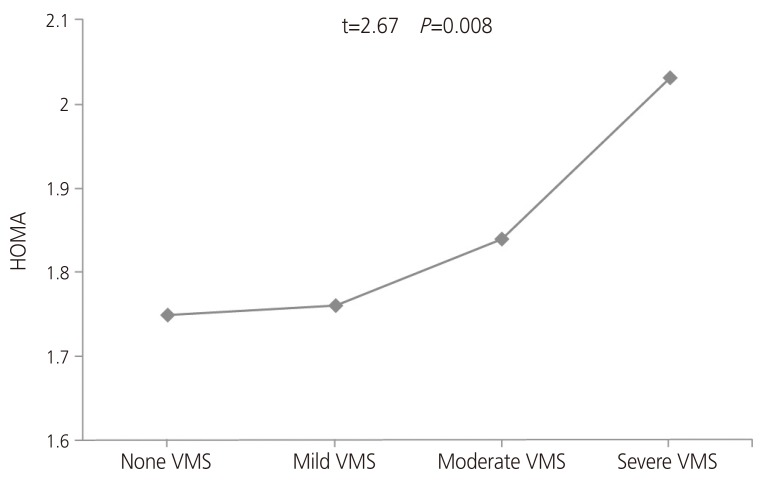Obstet Gynecol Sci.
2016 Jan;59(1):45-49. 10.5468/ogs.2016.59.1.45.
Vasomotor symptoms and the homeostatic model assessment of insulin-resistance in Korean postmenopausal women
- Affiliations
-
- 1Department of Obstetrics and Gynecology, Korea University Medical Center, Korea University College of Medicine, Seoul, Korea. tkim@kumc.or.kr
- 2Ulleung-gun County Hospital, Ulleung, Korea.
- KMID: 2152643
- DOI: http://doi.org/10.5468/ogs.2016.59.1.45
Abstract
- The aim of this cross-sectional study was to evaluate the association between vasomotor symptoms (VMS) and insulin resistance, which can be postulated by the homeostatic model assessment (HOMA) index. This study involved 1,547 Korean postmenopausal women (age, 45 to 65 years) attending a routine health check-up at a single institution in Korea from January 2010 to December 2012. A menopause rating scale questionnaire was used to assess the severity of VMS. The mean age of participants was 55.22+/-4.8 years and 885 (57.2%) reported VMS in some degree. The mean HOMA index was 1.79+/-0.96, and the HOMA index increased with an increase in severity of VMS (none, mild, moderate and severe) in logistic regression analysis (beta=0.068, t=2.665, P =0.008). Insulin resistance needs to be considered to understand the linkage between VMS and cardiometabolic disorders.
Keyword
Figure
Cited by 1 articles
-
Machine Learning Approaches to Identify Factors Associated with Women's Vasomotor Symptoms Using General Hospital Data
Ki-Jin Ryu, Kyong Wook Yi, Yong Jin Kim, Jung Ho Shin, Jun Young Hur, Tak Kim, Jong Bae Seo, Kwang-Sig Lee, Hyuntae Park
J Korean Med Sci. 2021;36(17):e122. doi: 10.3346/jkms.2021.36.e122.
Reference
-
1. Herber-Gast GC, Mishra GD, van der Schouw YT, Brown WJ, Dobson AJ. Risk factors for night sweats and hot flushes in midlife: results from a prospective cohort study. Menopause. 2013; 20:953–959. PMID: 23531688.2. Hunter M. The south-east England longitudinal study of the climacteric and postmenopause. Maturitas. 1992; 14:117–126. PMID: 1565020.
Article3. Ryu KJ, Park HT, Kwon DH, Yang KS, Kim YJ, Yi KW, et al. Vasomotor symptoms and metabolic syndrome in Korean postmenopausal women. Menopause. 2015; 22:1239–1245. PMID: 25899005.
Article4. Thurston RC, Sowers MR, Sutton-Tyrrell K, Everson-Rose SA, Lewis TT, Edmundowicz D, et al. Abdominal adiposity and hot flashes among midlife women. Menopause. 2008; 15:429–434. PMID: 18204407.
Article5. Gast GC, Grobbee DE, Pop VJ, Keyzer JJ, Wijnands-van Gent CJ, Samsioe GN, et al. Menopausal complaints are associated with cardiovascular risk factors. Hypertension. 2008; 51:1492–1498. PMID: 18391100.
Article6. Gast GC, Samsioe GN, Grobbee DE, Nilsson PM, van der Schouw YT. Vasomotor symptoms, estradiol levels and cardiovascular risk profile in women. Maturitas. 2010; 66:285–290. PMID: 20400247.
Article7. Chedraui P, Hidalgo L, Chavez D, Morocho N, Alvarado M, Huc A. Menopausal symptoms and associated risk factors among postmenopausal women screened for the metabolic syndrome. Arch Gynecol Obstet. 2007; 275:161–168. PMID: 17021775.
Article8. Lee SW, Jo HH, Kim MR, Kwon DJ, You YO, Kim JH. Association between menopausal symptoms and metabolic syndrome in postmenopausal women. Arch Gynecol Obstet. 2012; 285:541–548. PMID: 21853251.
Article9. Thurston RC, El Khoudary SR, Sutton-Tyrrell K, Crandall CJ, Sternfeld B, Joffe H, et al. Vasomotor symptoms and insulin resistance in the study of women's health across the nation. J Clin Endocrinol Metab. 2012; 97:3487–3494. PMID: 22851488.
Article10. Hauser GA, Huber IC, Keller PJ, Lauritzen C, Schneider HP. Evaluation of climacteric symptoms (Menopause Rating Scale). Zentralbl Gynakol. 1994; 116:16–23. PMID: 8147175.11. Matthews DR, Hosker JP, Rudenski AS, Naylor BA, Treacher DF, Turner RC. Homeostasis model assessment: insulin resistance and beta-cell function from fasting plasma glucose and insulin concentrations in man. Diabetologia. 1985; 28:412–419. PMID: 3899825.12. Hou ZM, Sun Q, Liu YZ, Chen TF, Tang N. Effects of insulin resistance on myometrial growth. Int J Clin Exp Med. 2015; 8:1552–1557. PMID: 25785172.13. Clapauch R, Mourao AF, Mecenas AS, Maranhao PA, Rossini A, Bouskela E. Endothelial function and insulin resistance in early postmenopausal women with cardiovascular risk factors: importance of ESR1 and NOS3 polymorphisms. PLoS One. 2014; 9:e103444. PMID: 25077953.
Article14. Lo JC, Zhao X, Scuteri A, Brockwell S, Sowers MR. The association of genetic polymorphisms in sex hormone biosynthesis and action with insulin sensitivity and diabetes mellitus in women at midlife. Am J Med. 2006; 119(9 Suppl 1):S69–S78. PMID: 16949391.
Article15. Burger HG, Dudley EC, Robertson DM, Dennerstein L. Hormonal changes in the menopause transition. Recent Prog Horm Res. 2002; 57:257–275. PMID: 12017547.
Article16. Eckel RH. The metabolic syndrome. In : Longo DL, Fauci AS, Kasper DL, Hauser SL, Jameson JL, Loscalzo J, editors. Harrison's principles of internal medicine. 18th ed. New York (NY): McGraw-Hill Companies;2012. p. 1992–1997.17. Freedman RR. Pathophysiology and treatment of menopausal hot flashes. Semin Reprod Med. 2005; 23:117–125. PMID: 15852197.
Article18. Cagnacci A, Cannoletta M, Caretto S, Zanin R, Xholli A, Volpe A. Increased cortisol level: a possible link between climacteric symptoms and cardiovascular risk factors. Menopause. 2011; 18:273–278. PMID: 21037488.
- Full Text Links
- Actions
-
Cited
- CITED
-
- Close
- Share
- Similar articles
-
- Predictors of Insulin Resistance in Postmenopausal Women
- Comparative Study of Serum Leptin and Insulin Resistance Levels Between Korean Postmenopausal Vegetarian and Non-vegetarian Women
- Association between the Thigh Muscle and Insulin Resistance According to Body Mass Index in Middle-Aged Korean Adults
- Association between Relative Handgrip Strength and Insulin Resistance in Korean Elderly Men without Diabetes: Findings of the 2015 Korea National Health Nutrition Examination Survey
- Differential Association of History of Premenstrual Syndrome/ Premenstrual Dysphoric Disorder with Vasomotor Symptoms According to Menopausal Stage


